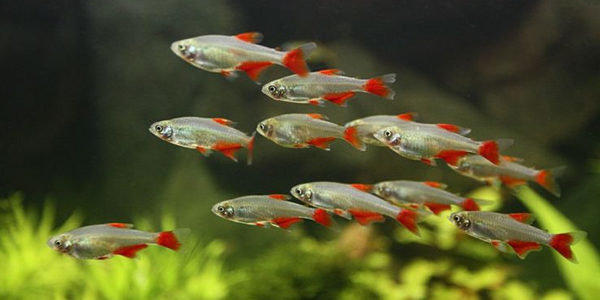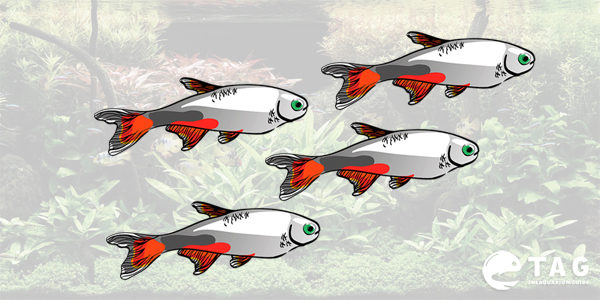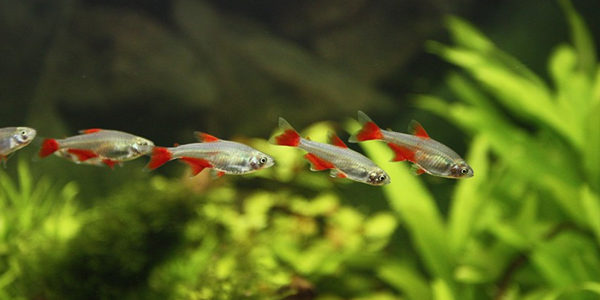The Bloodfin tetra, also known as True Bloodfin, Redfin Tetra, or Glass Bloodfin, is a very appreciated freshwater fish, especially by beginners, as it is very easy to care for and quite hardy.
Even more skilled aquarists will sometimes add a school of these fish to their tanks from time to time because they love this little active schooling fish.
Many people like the Bloodfin Tetra for their beautiful, yet discreet, coloration.
They have silver bodies with a greenish tone, depending on the aquarium lighting, and red fins, which give these fish their name.
They usually reach about 2 inches long and their typical lifespan is between 5 to 7 years.
Table of Contents
Bloodfin Tetra Care Guide [Overview]
Bloodfin tetra is an easy-to-care-for fish that lives for an average of seven years. It prefers being fed foods like worms and shrimp and requires a water temperature of 70-80 degrees Fahrenheit. It would be best to purchase a 10 or 20-gallon tank because these fish need a lot of room to swim.

Tank Requirements and Region
The minimum tank for a small school of about 5-7 fish is between 10-20 gallons, but a larger one is always better, as it provides more swimming space.
The Glass Bloodfin usually swims in the middle to upper sections of the tank.
If acclimated properly and kept within the same water parameters, the Bloodfin Tetra will become very hardy and easy to care for.
They like a water pH between 6-8.0 and will thrive in cooler water temperatures between 70-80 degrees Fahrenheit.
This is why they are sometimes kept in cold water aquariums or aquariums without a heater.
Though it is always best to use a heater to keep the water temperature stable, as large fluctuations will stress your fish.
As for the decorations, the Bloodfin Tetra love lush, live vegetation in their tank, as this recreates their natural habitat in the South American river basins.
If you worry about not being able to deal with live plants, you can use Java moss, which flourish in most conditions.
Also, you can place silk artificial plants, but avoid plastic ones, as they may hurt your delicate tetras.

Feeding
As they like to feed on worms and small insects in the wild, the Bloodfin Tetra enjoy classical flake food, but it’s best to feed them tubifex worms, silk worms, daphnia, brine shrimp, dried food, or frozen food occasionally to make sure they get all the nutrients they need.
A varied diet is always the best option; alternate carnivore food with plant or vegetable foods.
Being very active fish, the Bloodfin Tetra will need a lot of food, but the general rule of not feeding them more than they can consume in 3 minutes still remains.
Diseases
If kept in suitable conditions and fed a good quality well-balanced diet, the Bloodfin Tetras will hardly become ill.
Try to avoid any stressful situations, as they are known to reduce any fish’s immunity.
They can be effected by usual freshwater fish diseases and parasites like worms, protozoa, bacterial infections, skin flukes, etc., but the good news is being such a hardy fish, only a few individuals may be effected if dealt with in an early stage.
Be very careful what you introduce to your established tank and quarantine any new plants or fish before adding them.
Behavior
The Bloodfin Tetra may be a bit shy at the beginning, especially if not kept in a large school, as they are schooling fish, they feel more secure and happy inside a large group.
Being so small, you have the advantage of being able to house several Bloodfins in your tank at a time.
These are quite active and fast swimming fish, so they will surely animate your aquarium.
Occasional nipping at each other is a normal behavior, unless it escalates and gets too out of hand then remove the nipper.
Tank mates

Suitable tank mates for the Bloodfin Tetra are peaceful fish, not much bigger than they are, and will not threaten to eat them.
Usually, community tanks with other schooling fish of about the same size or not much larger would be perfect for them.
Never house your True Bloodfins with boisterous fish or this will stress them a lot.
They feel more at ease between their own kind and, if not kept in schools of 6 or more, they become testy and nip at slow swimming, long-finned fish.
Usually, other tetras of the same size, small Loricaiids or cories, are good tank mates.
Also, shrimp, snails, and crabs are also good tank mates, as they are very peaceful animals.
Breeding
The Bloodfin Tetras are egg layers that like their privacy during breeding.
The breeding tank should have very low lighting and the water should be more acidic.
In order to improve their health condition and make them able to reproduce properly, give them high-quality food that is rich in nutrients, like brine shrimp.
After a few days, 300 to 500 eggs will be laid on plants with wide leaves, so make sure you provide a suitable amount of these plants.
Remember to remove the parents after the female lays her eggs if you want to keep the fry.
Enjoying Bloodfin Tetra
If you have not tried to keep these little fellows, maybe you should add them now and enjoy the activity in your tank.
Remember to allow them plenty of open space for swimming.
Your aquarium will be full of life with a few Bloodfin Tetra added to it!

5 thoughts on “Bloodfin Tetra Care Guide”
I would like to know if I can place them along with some neon tetras and a betta.
yes they make a good tank mates for betta.
Would these make good tank mates with a dwarf gourami?
Our blood fin tetras are doing great alongside our dwarf Gouramis:-)
Do they eat snails?